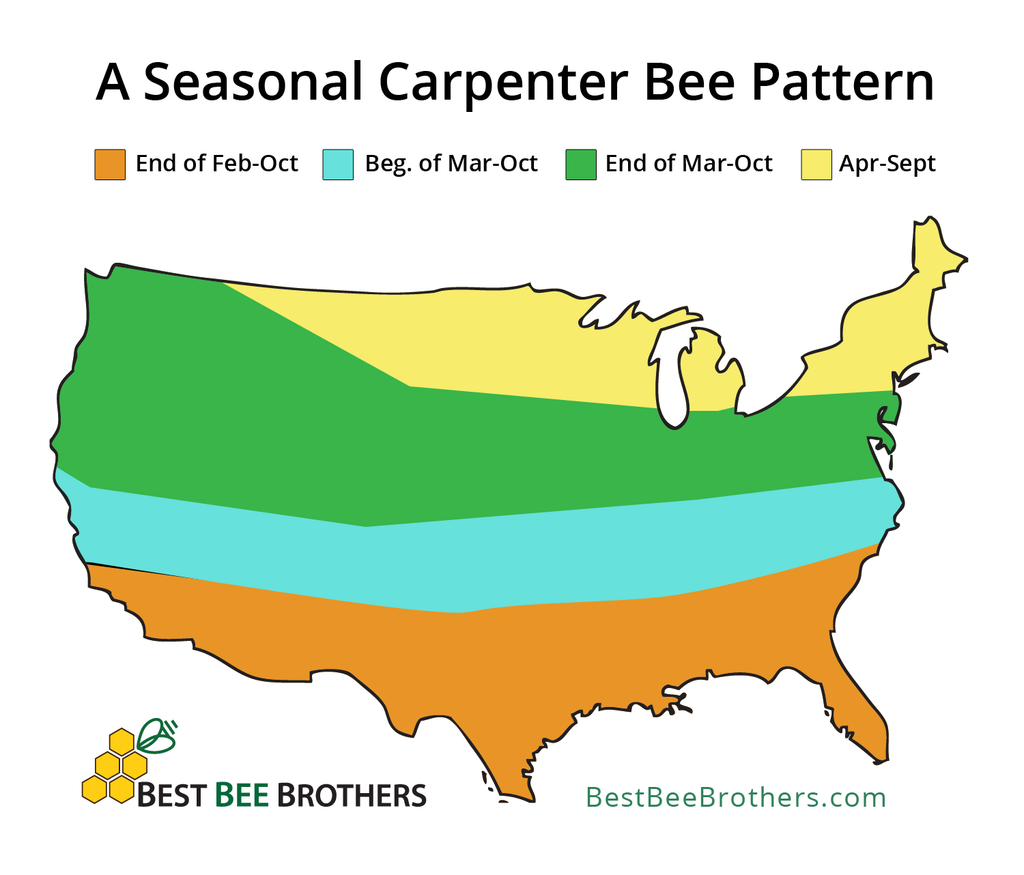Carpenter Bee Seasonality
Hundreds of carpenter bee species exist in the world, however, only a few live in the United States. Yet their impressive range stretches across the entire United States. Understanding the different types of carpenter bees is important, but knowing the times of year when they pose the greatest threat gives homeowners the knowledge they need to prevent damage to their homes. Awareness of nesting periods, paired with a Best Bee Brothers Carpenter Bee traps, is the best defense for protecting your home from carpenter bee infestations.
It is important to be able to identify if you have carpenter bees near your home (in comparison to honey or bumble bees which can look very similar) as Best Bee Brother’s Traps are designed specifically to attract and capture carpenter bees. Because of their specific engineering, these traps would be useless against warding off other types bee infestations.
Male carpenter bees are quite aggressive if you get near their hive, but they do not have stingers and are largely harmless. Females have stingers but are generally not aggressive and will not sting if they are not provoked.
Carpenter bees are quite destructive, especially to wooden structures.

Carpenter bees thrive in warm weather. The warmer the climate, the longer the activity period. Their habitats are split into four zones across the United States stretching from east to west. The following describes the four carpenter bee zones in the United States:
Orange Zone: Southern
The Orange Zone extends from southern California to South Carolina in the southern-most areas of the country and has the longest activity period -- February through October -- because naturally that is where the weather is warmest. Carpenter bees breed and build nests during warm weather, and these areas provide prime environments for home infestations.
The California Carpenter Bee -- known to experts as Xylocopa California -- and the Valley Carpenter Bee, known as Xylocopa Varipuncta, are especially prevalent in this zone.
The areas affected include southern California; Arizona; New Mexico; Texas; Georgia; Alabama; Florida and South Carolina. It is best to get ahead of the February through October carpenter bee season by installing Best Bee Brothers Carpenter Bee Traps to start prevention in January.
Blue Zone: South Central
Carpenter bee season in the Blue Zone begins in March and extends through October, with the best time to start prevention with Best Bee Brothers Carpenter Bee Traps during mid-February.
If you live in an area roughly bordered by Virginia; North Carolina; Tennessee; Missouri; Kentucky; Kansas; Kentucky, west to Nevada and central California, you would most likely encounter Southern Carpenter Bees, Xylocopa Micans; Eastern Carpenter Bees, Xylocopa Virginica; and the California Carpenter Bee, known as Xylocopa California.
Green Zone: North Central
The Green Zone has a slightly shorter season for carpenter bees, but as winter recedes the bees begin nesting. Ohio, Illinois, Indiana, northern California, Washington, Idaho and Oregon are all hosts to Eastern Carpenter bees (Xylocopa virginica) during a season that begins in March and ends in October. Use Best Bee Brothers Carpenter Bee Traps in late February and early March for best prevention of infestation.
Yellow Zone: Northern
The Yellow Zone is the northernmost area for carpenter bees. The area includes Maine, Minnesota, New Hampshire, New York and Wisconsin. Carpenter bee season is shortest in this zone, extending from the end of March through October. Prevention of infestations by the Eastern Carpenter Bee (Xylocopa virginica) should begin with the installation of Best Bee Brothers Bee Traps in late February and early March.
Carpenter bees are destructive pests. But by being proactive and looking for signs of carpenter bees building nests in structural wood, you can prevent damage to your home or other outdoor structures by using Best Bee Brothers Carpenter Bee Traps.
To learn more about the types of carpenter bees which may inhabit your area, check out our Types of Carpenter Bees page.